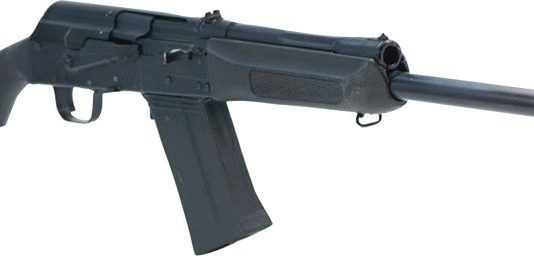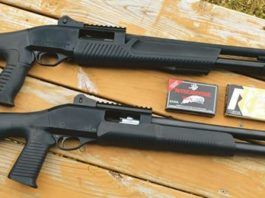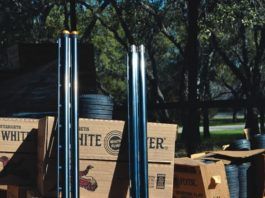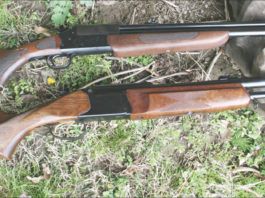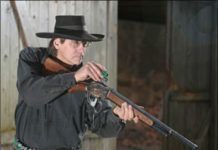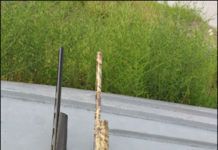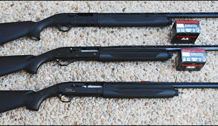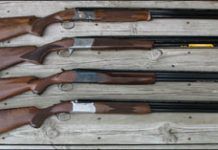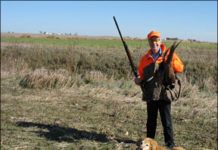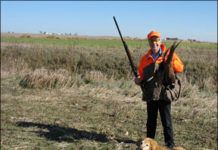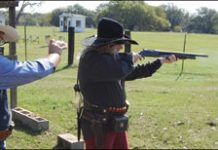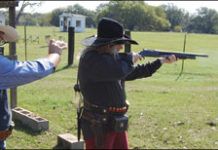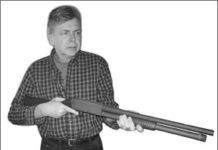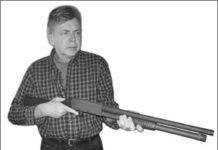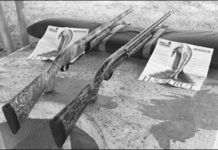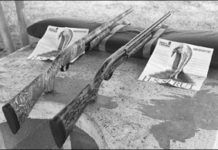Lever-Action 1887 Shotguns: Armi Chiappa Vs. Norinco
That gun is the Winchester Model 1887, a lever-action shotgun originally designed by John Browning and produced by the Winchester Repeating Arms Company during the late 19th and early 20th centuries. The www.callofduty.wikia.com site says of the ancient firepower, "The Model 1887 originally used black powder 12-gauge shells and 10-gauge shells, but replicas made today are often chambered for more common modern ammunition." Further, the site notes that, "The Model 1887 is the only lever-action gun to ever be featured in a Call of Duty game."
Well, yes, because the design isn't a popular choice for shotguns, with semiautos, pumps, and double-barrels being more popular products. But the infatuation with the 1887 lever shotgun doesn't stop there.
In Terminator 2: Judgment Day (a 1991 sequel to Jim Cameron's original film, Terminator), a Terminator (Arnold Schwarzenegger) T-800 cyborg is sent back in time to protect Sarah Connor (Linda Hamilton) and son John Conner (Edward Furlong) from the more advanced T-1000 Terminator (Robert Patrick).
Probably the most recognizable weapon carried by Terminator Schwarzenneger is the highly customized 12-gauge 1887 Winchester lever-action shotgun. The character is seen holding this weapon (atop his Harley Davidson motorcycle) on the one-sheet posters and key publicity material. The movie gun was customized with a variety of lever handles used, such as the loop style for "swing-cocking" on the Harley Davidson.
Also, Brendan Fraser used a cut-down pistol-gripped Norinco copy of the Winchester 1887 in The Mummy Returns, most notably in the bus scene.
We understand the use of the 1887 in the Mummy movies—they're period pieces, and the 1887 fits. The initial runs of 1887s were made by Winchester in New Haven, Connecticut. They are notable for a small hammer spur at the top of the action, a solid lever, and a ball-type pistol grip on the buttstock. Most had fluid steel barrels, though some had Damascus steel and were only safe to use blackpowder. They were made from 1887 to 1901, about 65,000 in all.
Coming back to current times—in a way—the 1887 is widely used in Cowboy Action events, but perhaps most fluently by SASS champion "Gunfighter" Lassiter, aka Tom Wildenauer. Starting with an open action, he's able to load two and shoot two in under 3 seconds. Not bad for a design that few have seen and fewer have shot.
So, with all this interest in the 1887, we wanted to compare a couple of current production models to see which one we'd buy for fun shooting. Our test guns were the IAC Imports Reproduction Cowboy 1887 87W-1 lever action, $600; and the Armi Chiappa 1887 Fast Load 930.004, which we found selling under the Puma name by Legacy Sports International for $1229. Both guns have 12-gauge barrels chambered for 2.75-inch modern shells. The IAC has a 20-inch barrel with a fixed Cylinder choke and a five-round-capacity tubular magazine. The Chiappa we tested had a 22-inch barrel and was threaded for choke tubes and and came with a Cylinder screw-in tube. It had a total capacity of two because of an action modification that speeds reloads for CAS at the expense of total round count.
Here's what we thought of them:
Super-Auto Shootout: Benellis SBE II Versus Browning Maxus
It is an old story in the gun business: Fancy new model gets announced; months later prototypes leak out for promotional media testing; then, finally, a year (or two) later, real guns start shipping. And so it is with Browning's Maxus, which was announced in November 2008, with some prototypes available to shoot at the January 2009 SHOT Show in Orlando, and lagging production. Originally slated for late-spring-2009 availability, early-fall delivery has proved to be the case instead—and then, only for the 31/2-inch-chamber models.
The initial offerings of Browning's new-for-2009 autoloader is the matte Stalker style and also a Mossy Oak Duck Blind camo version for $1499 MSRP, both with 31/2-inch chambers. The 3-inch versions are said to be arriving soon—again, in either Stalker matte black or camo for now.
Included in all the "Planet Maxus" hoopla, Browning has made several claims about the Maxus and touted several new features. A few of the features aren't particularly meaningful, so let's dispense with these first. The "Turnkey" quick-change magazine plug is hardly of any use in a dedicated field gun, one directed to waterfowl at that, where three shots (2+1) is going to be it.
Things like shim adjustments for drop are nice to have, of course, and were a bit more remarkable when they appeared 20 years ago. Now, they have become so prevalent that it seems more like a glaring oversight when new autoloaders fail to provide this feature. Naturally, we are glad they are included in the Maxus, but this is no different from many autoloaders. We do note that the Maxus has adjustable length of pull, with the appropriate buttstock spacers included right in the box—not an optional accessory, but already supplied.
Burrowing deeper into the Maxus, Browning has promised us not just cosmetics, but a new gas action and trigger system that moves beyond the similarly weighted Winchester SX3 Composite ($1239 MSRP) and its Browning rendition, the half-pound-heavier Browning Silver Stalker ($1179 MSRP). Rather than an afterthought, the Maxus was designed from the start to be a 31/2-inch gun, and it appears that Browning hopes the Maxus will outscore both the Beretta Xtrema2 and the stalwart Super Black Eagle II.
There are a number of shotguns against which we could pit the new Maxus, but to clean up the field and make the comparisons truly head to head, we chose to bring in an "Our Pick" from the January 2007 issue. There, we tested the Benelli Super Black Eagle II No. 10016 12 gauge, $1515, rating it above the Beretta Urika Optima and Remington 105Cti. Almost three years ago, we wrote of the SBE II, "The latest version of the evolving Super Black Eagle design is a comfortable, ever-functional hunting gun, with the capacity to shoot 23/4-, 3-, and 31/2-inch ammunition." If the Maxus could compete against the SBE II, we reasoned, then its successful launch into the world's autoloading shotgun pool would be assured. Toward that end, we acquired a Benelli Super Black Eagle II No. 10101 Max-4 HD Camo 31/2-inch 12 gauge, $1759, to compete with the Browning Maxus Stalker No. 011600204 31/2-inch 12 Gauge, $1379.
Here's what we found:
Semiauto 12 Gauges: S&W Edges Browning and Winchester
Back-to-the-basicsshotguns featuring black composite stocks and forearms fill a special niche in the world of scattergun enthusiasts. These firearms are picked for their ability to serve as a shooting tool that can withstand rugged hunting conditions and not with a lot of attention to appearance. They also eliminate the possibility of a flash of sunlight glinting off a shiny stock or barrel and alerting incoming waterfowl of potential danger.
Most of the major manufacturers offer at least a few of their shotgun models featuring composite stocks and forearms and non-glare barrels, and a variety of the shotguns make their way to the used gun racks where shooters are looking to pick up a bargain.
The three used composite semiautomatic shotguns we gathered for our test included the Smith & Wesson Model 1012, $630; the Winchester Super X Model 2, $600; and the Browning Gold Hunter, $700. While the trio's prices are probably in the moderate-to-high-end range for a used semiautomatic, we picked them as a good representation of how composites compared in the field and on the range.
The Winchester Super X2 is the same model reviewed by Gun Tests in March 2004, when it was pitted against a Mossberg 935. The Winchester was our pick in that match-up. In addition, we looked at a Super X3 versus a Benelli M2 in November 2007 and also gave the Winchester model a thumbs up in that comparison. In both cases, we were pleased with the Winchester's handling ability; functioning features; and the speed of the action over the other shotguns in those tests.
This latest match up involved two more recent introductions into the composite stock and forearm world of shotguns, and we were interested in determining how the veteran Winchester would fare.
To check out the shotguns in a variety of shooting situations, we selected the following test ammunition:
For clay targets, we used Winchester AA Light Target 23/4-inch loads with 11/8 ounce of No. 8 shot and an average muzzle velocity of 1145 fps; and Winchester Super Sport Sporting Clays 23/4-inch loads with 11/8 ounce of No. 71/2 shot and an average muzzle velocity of 1300 fps. It should be noted that none of the three shotguns would function well with the light target loads, resulting in numerous failures to feed a second shot. These shell-feeding problems were eliminated when we switched to the hotter sporting clays shells.
For the patterning tests, we selected Federal Steel Duck and Pheasant 3-inch loads with 1.25 ounces of BB shot and a muzzle velocity of 1300 fps. No functioning problems were encountered with any of the shotguns when firing the 3-inch shells.
We also function-fired several 31/2-inch shells, Estate High Velocity Magnum Steel with 13/8 ounces of No. 4 shot and an average muzzle velocity of 1,500 fps. We wanted to see how the Browning and Winchester would handle the heavy loads. The Smith & Wesson is limited to no more than 3-inch shells.
While there were no functioning problems, there was quite a bit of shoulder shock when firing the 31/2-inch loads in the Browning. Probably because of the Winchester's heavier weight, there was no appreciable difference in recoil between 3-inch and 31/2-inch loads. However, we were happy to limit our practice time with the big shells to only a few rounds.
We were generally pleased with the way all three of the shotguns could be moved onto targets on the clays course and with the trio's patterning performance using steel shot on paper targets set at a range of 30 yards.
Details of how each shotgun performed at the clay target range and patterning field follows in our report:
Over/Unders: Caesar Guerini, Ruger, Browning, & Winchester
12-Gauge Autoloader Shoot-Out: Beretta, Benelli, and Remington
12-Gauge Autoloader Shoot-Out: Beretta, Benelli, and Remington
Duel at the Mostly OK Corral: 12-Ga. Cowboy Action Shotguns
Duel at the Mostly OK Corral: 12-Ga. Cowboy Action Shotguns
Home-Defense 12-Gauge Pumps: Ithaca, Remington, Mossberg
Perhaps due to the "Obama-effect"—wherein the fear of future gun bans is driving sales—the home-defense/tactical class of self-defense shotguns is booming like never before. But we must recognize that other factors figure into the segment's sales rise as well, not the least of which is that a 12-gauge pump-action shotgun is an effective close-quarters weapon.
To wit: The M97 version of John Browning's Winchester 1897 shotgun was the original "trench-sweeper." Widely considered the first truly successful pump shotgun, the M97 was fitted with a heat shield and the M1917 16-inch bayonet for combat duty. The highly effective use of the shotgun by United States forces in WWI had a dramatic effect on the morale of front-line German troops. As a result, on September 19 of 1918, the German government issued a diplomatic protest against the American use of shotguns, alleging that the law of war prohibited the shotgun. The 5+1 capacity M97 and OO buckshot defined the fast-handling, reliable close-quarters shotgun for about 30 years, the platform of the high-capacity pump persisting through to present day.
The reason to consider a shotgun for personal defense is what many combat studies have shown: the hit probability of a shotgun is roughly twice that of a rifle. For home defense, the shotgun is a quicker stopper than a handgun due to its being able to produce more wound trauma with multiple wound paths. It is considered easier to use in a high-stress situation, and minimizes wall penetration compared to some handgun ammunition. It is also economical to practice with.
Number 1 Buckshot is 30 caliber; it is the superior choice as defined by the International Wound Ballistics Association: "Number 1 buck is the smallest diameter shot that reliably and consistently penetrates more than 12 inches of standard ordnance gelatin when fired at typical shotgun engagement distances. A standard 2-inch 12-gauge shotshell contains 16 pellets of #1 buck. The total combined cross sectional area of the 16 pellets is 1.13 square inches. Compared to the total combined cross sectional area of the nine pellets in a standard #00 (double-aught) buck shotshell (0.77 square inches), the # 1 buck shotshell has the capacity to produce over 30 percent more potentially effective wound trauma. In all shotshell loads, number 1 buckshot produces more effective wound trauma than either #00 or #000 buck. Also, #1 buck is less likely to over-penetrate and exit an attacker's body." (For further reading, consult Dr. Martin Fackler and Duncan MacPherson's works on bullet penetration and wounding ballistics.)
This match-up includes the Ithaca Model 37 Defense Gun ($469), very close to the M37 "Trench Gun" that saw action in WWII and in Vietnam; the Remington Model 870 Tac-2 FS ($692), and the Mossberg 590A1 w/Black Aluminum Adjustable Stock ($693). The Mossberg 590A1 in various configurations is currently an active service shotgun for the U.S. Military. Here's what our test team thought about the trio:
Home-Defense 12-Gauge Pumps: Ithaca, Remington, Mossberg
Perhaps due to the "Obama-effect"—wherein the fear of future gun bans is driving sales—the home-defense/tactical class of self-defense shotguns is booming like never before. But we must recognize that other factors figure into the segment's sales rise as well, not the least of which is that a 12-gauge pump-action shotgun is an effective close-quarters weapon.
To wit: The M97 version of John Browning's Winchester 1897 shotgun was the original "trench-sweeper." Widely considered the first truly successful pump shotgun, the M97 was fitted with a heat shield and the M1917 16-inch bayonet for combat duty. The highly effective use of the shotgun by United States forces in WWI had a dramatic effect on the morale of front-line German troops. As a result, on September 19 of 1918, the German government issued a diplomatic protest against the American use of shotguns, alleging that the law of war prohibited the shotgun. The 5+1 capacity M97 and OO buckshot defined the fast-handling, reliable close-quarters shotgun for about 30 years, the platform of the high-capacity pump persisting through to present day.
The reason to consider a shotgun for personal defense is what many combat studies have shown: the hit probability of a shotgun is roughly twice that of a rifle. For home defense, the shotgun is a quicker stopper than a handgun due to its being able to produce more wound trauma with multiple wound paths. It is considered easier to use in a high-stress situation, and minimizes wall penetration compared to some handgun ammunition. It is also economical to practice with.
Number 1 Buckshot is 30 caliber; it is the superior choice as defined by the International Wound Ballistics Association: "Number 1 buck is the smallest diameter shot that reliably and consistently penetrates more than 12 inches of standard ordnance gelatin when fired at typical shotgun engagement distances. A standard 2-inch 12-gauge shotshell contains 16 pellets of #1 buck. The total combined cross sectional area of the 16 pellets is 1.13 square inches. Compared to the total combined cross sectional area of the nine pellets in a standard #00 (double-aught) buck shotshell (0.77 square inches), the # 1 buck shotshell has the capacity to produce over 30 percent more potentially effective wound trauma. In all shotshell loads, number 1 buckshot produces more effective wound trauma than either #00 or #000 buck. Also, #1 buck is less likely to over-penetrate and exit an attacker's body." (For further reading, consult Dr. Martin Fackler and Duncan MacPherson's works on bullet penetration and wounding ballistics.)
This match-up includes the Ithaca Model 37 Defense Gun ($469), very close to the M37 "Trench Gun" that saw action in WWII and in Vietnam; the Remington Model 870 Tac-2 FS ($692), and the Mossberg 590A1 w/Black Aluminum Adjustable Stock ($693). The Mossberg 590A1 in various configurations is currently an active service shotgun for the U.S. Military. Here's what our test team thought about the trio:


























